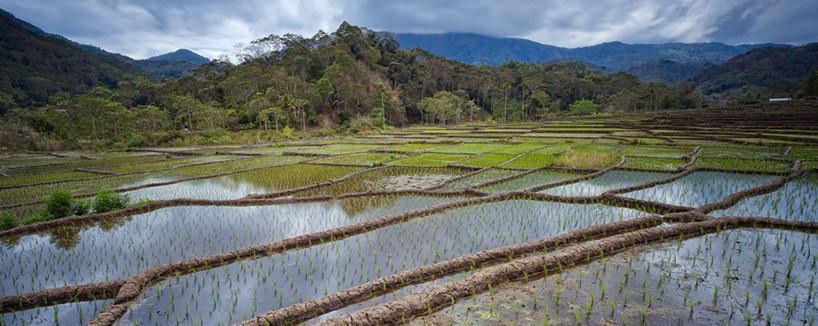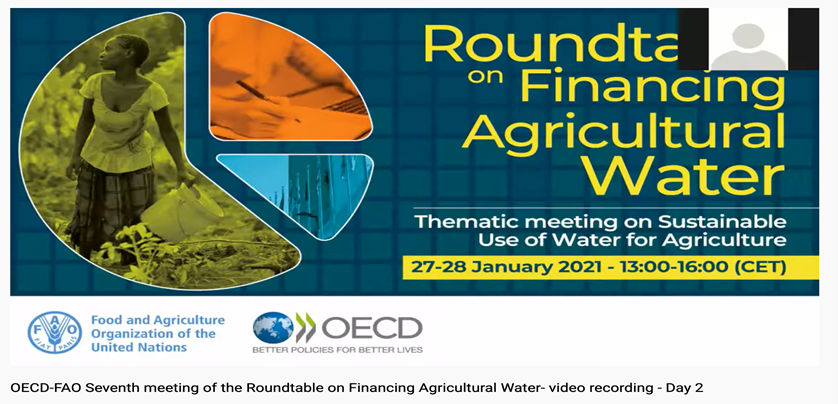Best Practices > Details
Mobilising Commercial Finance to Scale up Investment Towards Sustainable and Resilient Agricultural Water Management
28/01/2020

Mobilising Commercial Finance to Scale up Investment Towards Sustainable and Resilient Agricultural Water Management
©@FAO
Sustainable water use in agriculture has a key role to play in achieving the Sustainable Development Goals (SDGs), the Paris Agreement and other policy objectives. This will require a substantial increase in finance and better targeting of existing financing
flows. In particular, significant additional capital is needed to support the transition towards sustainable agriculture, including investment in innovation, infrastructure, water use efficiency improvements and capacity building.
Select
estimates highlight the magnitude of the challenge. For example, globally, at least USD 300 billion are estimated to be required annually to meet the SDGs related to food security. An estimated total of USD 3.1 billion per year are required to meet
the projected irrigation expansions across developing countries in the FAO-sub-regions of East Asia and Pacific, and South Asia between 2015-30. Agriculture is mostly funded by the public sector but expenditure levels often remain insufficient. Out
of 13 countries in the Arab region, 10 have public spending levels for agriculture of only 60% or less from the levels considered “optimal” to achieve policy goals.
Given the substantial investment needs to transition
towards sustainable and resilient agricultural water management. Public spending is still the key source of funding (both for new and recurrent investments), but it is often insufficient to even meet recurrent costs related to management, operation
and maintenance needs. Agricultural water receives a very minor share of development assistance: aid flows to the sector show high year-to-year variation, accounting for about 1 percent of the total aid to the Near East and North Africa Region and
this has not increased over the past decade.
Some bilateral donors, notably China, are becoming important sources of investment and new forms of funding are gaining in importance, such as the Green Climate Fund, Clean Development
Mechanism, green bonds and blended finance.
It is, however, essential to mobilise additional sources of finance to complement public funds. Commercial finance can help bridging the financing gap. The mobilisation of commercial
finance requires a robust enabling environment with institutional arrangements, clearly defined roles and capacities and available data and information.
Private investors, including farmers, also play a significant, yet often unaccounted
for, role in agricultural water investments, both in irrigation expansion through groundwater wells and in the operation and maintenance of surface irrigation schemes.
FAO’s Investment Centre helps to strengthen the enabling environment
FAO’s Investment Centre facilitates public-private policy dialogues to improve the enabling environment for private investors. It supports the
improvement of the efficiency and sustainability of food value chains to open new market opportunities and provides private investors with training, market research and innovation. In 2018, the European Bank for Reconstruction and Development
and the Investment Centre jointly signed 16 new technical assistance assignments in nine countries for a total amount of USD 5.8 million. FAO-EBRD projects have been located in countries such as Ukraine and Serbia, Kazakhstan and Kyrgyz Republic or
Morocco.
Cost-share irrigation investments in Chile
The Chilean government has set up a public private partnership (PPP) arrangement to mobilise private investment for dam constructions. Between 2014 and 2018, the Chilean government
launched the construction of five large dams, allowing for irrigation of around 8 000 farms covering 40 000 ha in the central and northern regions, for a total investment of USD 1.3 billion. Three of the five dams were developed under a cost-share
mechanism: the state financed a part of the total cost, private investors built, exploit and maintain the dam, and the end users pay the license holder for water stored. Initially, the approach had faced opposition from farmers fearing higher costs
of water. Eventually, the project led farmers to shift their production to highvalue agriculture (e.g. fruit trees) or to sell their land to other farmers.
A second initiative to support private investment in irrigation in Chile is the
cost-share grant programme for small-scale initiatives. Under this programme, small and medium sized owners can complement their investments in irrigation and drainage projects for community or individual works with public grants. Since the according
law entered into force in 1986, about 23,000 farmers have benefitted from the program, which contributed to develop irrigation on 200,000 ha, including a growing number of small farmers over time. The programme also enabled 500,000 beneficiaries to
shift to pressurised irrigation, representing a total area of 325,000 ha.
Water funds and payments for ecosystem services:  Corporates with water-intensive activities and utilities, such as breweries or beverage companies or other stakeholder have an interest in improving or conserving water quality and quantity, which reduces their costs of water treatment or improve the
quality of their products. Water funds are collective investment vehicles which allow stakeholders to provide and pool capital to fund improved water management or to pay for ecosystem services (‘Beneficiary Pays’). Farmers can thus be
compensated for decreased fertiliser use and improved water management practices. The investments do not need to be repaid and investors do not get any return on investment. The profitability of such capital provision emerges from the positive impact
on actors in the spatial area reliant on water resources.
Corporates with water-intensive activities and utilities, such as breweries or beverage companies or other stakeholder have an interest in improving or conserving water quality and quantity, which reduces their costs of water treatment or improve the
quality of their products. Water funds are collective investment vehicles which allow stakeholders to provide and pool capital to fund improved water management or to pay for ecosystem services (‘Beneficiary Pays’). Farmers can thus be
compensated for decreased fertiliser use and improved water management practices. The investments do not need to be repaid and investors do not get any return on investment. The profitability of such capital provision emerges from the positive impact
on actors in the spatial area reliant on water resources.

In Philippines and after the successful pilot phase, the International Financing Cooperation (IFC) provided a seven-year concessional loan package at competitive market rates to Philippines, CARD SME Bank in 2016. The proceeds of the loan were blended with CARD SME Bank funds and disbursed to client farmers, tailored to their needs. Repayment is tailored to the production cycle. Financing is accompanied by advisory services enhancing farmers’ awareness of new technology, innovations and production and marketing strategies. With this approach, CARD SME Bank’s loan disbursement rose by 241% between 2016 and 2017 to reach underserved small-scale farmers and agribusinesses. With this new access to finance, farmers were able to expand production, input supply, and transportation and to improve their income.
The above case highlights the role for intermediaries, to minimise transaction costs and secure access to credit services Intermediaries can provide a bridge between project owners and financing institutions, by bundling projects together (thereby making them big enough to attract the attention of financiers), standardising review processes (aligning project features with standard operating procedures in commercial banks) or otherwise.

